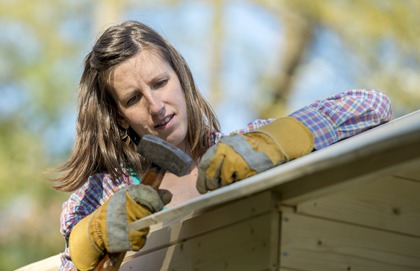Let me humbly attempt to say something on behalf of women.
Yeah, we can do anything. We know. Our second-wave feminist mothers showed us that. But somehow, the third wave hasn't washed over society powerfully enough to supplement the current female role models, which remain—perhaps more than ever—overwhelmingly pretty, pink, perky homemakers. And the trends begin in childhood.
As resident social media guru, I turn immediately to Pinterest to back up my point. I love this site: it's extremely useful and entertaining, whatever your interests are. With its romantic snapshots of DIY sewing projects, glittery home decor, and baking secrets, Pinterest has sent us back in time to reclaim the fifties. Which is great, except that I think we forgot to reclaim the previous decade.
Rosie the Riveter was a poster girl in the forties who told women that "if you can run an electric mixer, you can learn to operate a drill." And then the men came home from war, and you know the story.
Seven decades later, who are our poster girls?
At this point, you may be exclaiming, what about [insert a favourite celebrity female's name here]! She is a wonderful role model! She's real. She's fun. She's strong. I know, these ladies are out there. I love them too. But look at their lines of work: talk show host, magazine editor, blogger, singer, actress, politician's wife, or possibly athlete. Where are the craftspeople? Where are the CEOs? Where are the leaders of industry? Where are the hard workers?
According to a Statistics Canada study from a few years ago:
Overall, occupations in the trades tend largely to be non-traditional occupations for women. In 2007, for example, out of a total 24,495 individuals who completed an apprenticeship training program, females accounted for 2,780 or 11%. This proportion has been more or less steady since the mid-1990s but has increased from 1991 when it was 6%. However, in most of the major trade groups in 2007, the proportion of females was quite low, at between 1% and 2% of completions.
At Canada's New Industrial Revolution in Toronto yesterday, the session I personally enjoyed the most was the last of the day, and the only one featuring female speakers. The first was the Honourable Dr. Kellie Leitch, Canada's Minister of Labour and Minister of Status of Women, who pointed out the continued relevance of this issue: "We don't have the right people in the right places doing the right things."
 The panel for "Training Tomorrow's Workers for the Right Job in the Right Place": Brian Dijkema, Min. Manley McLachlan, Rosemary Sparks, Min. Kellie Leitch, and Alan Ross
The panel for "Training Tomorrow's Workers for the Right Job in the Right Place": Brian Dijkema, Min. Manley McLachlan, Rosemary Sparks, Min. Kellie Leitch, and Alan RossAccording to Minister Leitch, getting women into skilled professional trades requires us to show them the opportunities available and the value of them. "Most importantly," she joked, "they'll be able to afford hockey equipment so their kids can play hockey!"
The minister is exactly the kind of role model I'm looking for here. An orthopaedic pediatric surgeon by profession, she considered herself "a cross between an electrician and a carpenter." In her speech, she called women "one of the greatest untapped resources we have in the country … Not because they wouldn't enjoy the roles, but because they don't know what they entail. There are opportunities there."
And following Minister Leitch was Rosemary Sparks, another of the few remarkable women who belong in our ring of heroines. Currently the executive director of BuildForce Canada, she previously was director of projects at the Construction Sector Council, and has years of experience in the industry. Due to the baby boomers' impending retirement, she said yesterday, "Our estimate is that 235,000 workers are going to leave the construction industry over the next 10 years." Because projects require highly skilled workers with specific trades, Ms. Sparks said, young people need to see these jobs as attractive. "We are going to have to do some work to shift these young people's—and their influencers'—views about this narrow definition of the knowledge-based economy and make sure that they understand that the construction industry and skilled trades are part of the new definition."
But Ms. Sparks and her handful of peers are not enough. And to prove it, let's look at how the marketing rubber hits the road.
Oh, LEGO. I remember bins full of yellow, red, and blue bricks and the multitude of beautiful houses, cabins, hotels, and office buildings I created in my basement as a child. This is how LEGO looked when I was little.
Over Christmas, I played LEGO with my seven-year-old niece. That is, I attempted to. But as I searched through her bucket of pieces, I was mystified. Where were the big green bases? Where were the bulk of yellow 1x2s and red 2x4s? As I tried to assemble pink and purple pieces into the castle that was forming in my imagination, I was confronted with a lack of building materials. But my niece stopped me. "No, Aunt Naomi! Look at the instructions. We're building Emma's Sports Car!" Check out today's version of LEGO marketing for girls. Snapping five molded plastic pieces together isn't building play anymore than assembling a prefab bookshelf is carpentry. And without play to inspire a love of construction, girls won't pursue that path.
I don't care if your toys are pink, blue, green, yellow, black, or all of the above. The point is that we've allowed the creativity engrained in the trades to be wiped out in a swath of glitter and tulle.
There is hope here. Goldie Blox are geared to girls who want to learn how to build belt drive machines. Ana White takes the term "homemaker" literally and provides a little variety in the female blogging world. Minister Leitch and Ms. Sparks are showing women aspirational heights of success. But the onus is on us to remind young women that if they like working with tools, jewelry making isn't the only option. A career in energy, construction, or manufacturing could be trading up.






